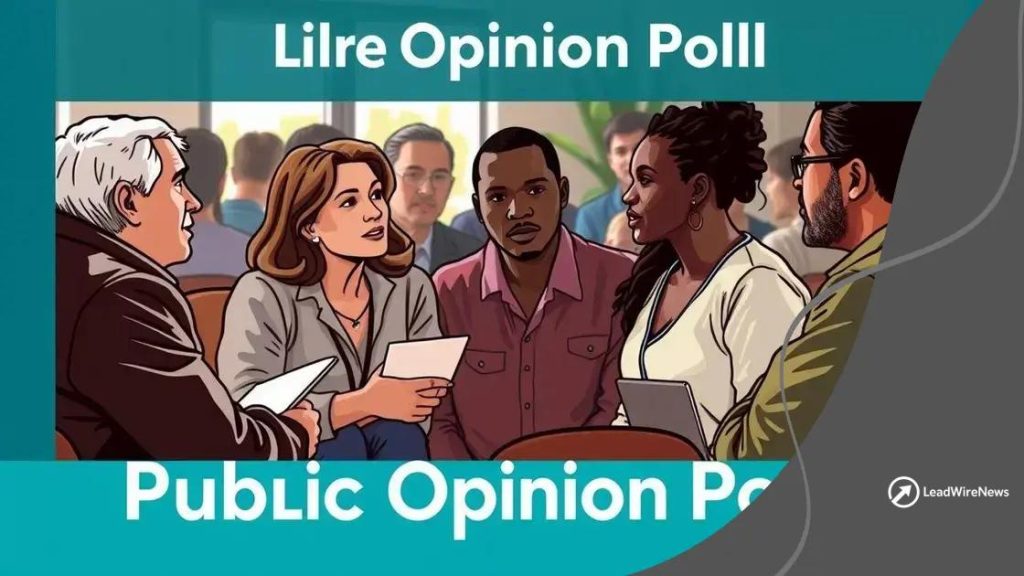Public opinion polls on key issues today

Anúncios
Public opinion polls influence decision-making by reflecting citizens’ sentiments on key issues, helping policymakers align their actions with the public voice and ensuring diverse perspectives are considered in governance.
Public opinion polls on key issues play a crucial role in shaping our understanding of societal trends. Have you ever wondered how these surveys impact decisions made by leaders? Let’s dive in.
Anúncios
The importance of public opinion polls
Understanding the importance of public opinion polls is vital in today’s democratic society. These polls provide insight into what the public thinks about various issues, influencing decisions made by leaders and policymakers.
Why Public Opinion Polls Matter
Public opinion polls serve as a snapshot of society’s values and beliefs at any given time. They help to gauge voter sentiment, giving a voice to the populace on critical topics. Moreover, they can forecast election outcomes and direct the focus of political campaigns.
Main Benefits
- They inform decision-makers about what the public cares about most.
- Polls help to identify trends over time, showcasing how opinions evolve.
- They provide feedback on policies being considered, allowing for adjustments based on public feedback.
In addition to aiding politicians, public opinion polls can empower citizens. By reflecting collective opinions, they help individuals understand the societal landscape. When people know how their views align with the majority, it can motivate them to engage more with civic duties.
Anúncios
However, it’s essential to recognize that public opinion polls can have limitations. For instance, sample bias may skew results. Not every demographic may be represented adequately, leading to misleading conclusions.
Another limitation is the response bias, where individuals may not always express their true feelings, particularly on sensitive topics.
Conclusion
In summary, understanding the importance of public opinion polls is key for effective participation in democracy. These tools not only enlighten decision-makers but also empower citizens by reflecting their views in the broader social context.
Understanding key issues in surveys
Understanding key issues in surveys is essential for interpreting public opinion accurately. Surveys can cover a wide range of topics, but certain issues often stand out due to their relevance to society. Recognizing these key issues helps to understand the data collected and its implications.
Common Key Issues
In many surveys, several recurring topics emerge. For instance, economic concerns frequently top the list, representing people’s worries about job security and inflation. Health care is another significant topic, especially regarding access and affordability.
- Economic concerns: Job security and inflation impacts.
- Health care access: Policies affecting costs and availability.
- Education: Public opinion on the quality and funding of schools.
These highlighted issues not only reflect public sentiment but also guide policymakers in making informed decisions. When analyzing survey data, it’s crucial to comprehend which issues resonate most with the population. This understanding helps in crafting messages during campaigns and public initiatives.
Furthermore, the context surrounding these issues greatly influences survey results. Current events, such as economic downturns or health crises, can sway public opinion. That’s why it’s vital to consider timing when interpreting data.
Impact of Key Issues
The impact of key issues in surveys can be profound. For instance, increasing concern about climate change in recent years has prompted more surveys focused on environmental policies. Understanding where public opinion lies can enable governments to create policies that reflect the electorate’s priorities.
Additionally, recognizing shifts in key issues helps organizations tailor their strategies effectively. They can communicate messages that resonate with the audience, driving engagement and support for their initiatives.
How polls influence policy making

Understanding how polls influence policy making is crucial for both voters and lawmakers. Public opinion polls gather data that shows how people feel about various issues. This information can significantly shape decisions made in government.
The Role of Polls in Government Decisions
Policymakers rely on surveys to assess public sentiment. When a particular issue garners significant attention in polls, leaders often adjust their policies to align with voter preferences. For example, if a poll indicates a majority support for environmental regulations, lawmakers may prioritize environmental bills for discussion.
Examples of Polls Impacting Policy
- Increases in public concern for healthcare led to reforms in national health policies.
- Polling data on education showed support for increased funding, influencing budget allocations.
- Surveys about public safety prompted policy changes in law enforcement strategies.
Understanding how polls reflect voter priorities can help ensure that elected officials stay accountable. When people express their views through surveys, it signals to lawmakers about pressing issues. When officials act in response to these signals, it fosters a more responsive government.
While polls can be a powerful tool, they also have limitations. Not all polls accurately capture the full range of public opinion. Biases in how questions are framed or in whom is surveyed can lead to skewed results. This is why reviewing multiple polls and their methodologies is critical.
The influence of polls on policy making shapes the very fabric of democracy. By listening to the voices reflected in survey results, officials can create policies that more accurately represent the needs and desires of their constituents.
Challenges in interpreting poll results
Interpreting poll results can present several challenges. Understanding these challenges is vital for grasping the true significance behind collected data. One frequent issue is the sampling bias that can occur if the surveyed group is not representative of the larger population.
Common Challenges
When looking at poll results, it’s important to consider how the data was gathered. Polling methods can lead to varied results based on how questions are phrased or who is asked. For example, if a survey targets only specific demographics, it may overlook other critical viewpoints.
- Sampling bias: Failing to include diverse groups can result in skewed findings.
- Question phrasing: Leading questions may influence responses and alter the outcome.
- Timing: The moment a poll is conducted can affect public sentiment, especially during crises or major events.
Another challenge is response bias, where respondents may not provide honest answers, particularly on sensitive topics. Some may avoid sharing their true opinions due to fear of judgment or social stigma. This issue can significantly distort the actual sentiment of the population.
Additionally, understanding the margin of error is essential. A small margin may indicate strong consensus, while a larger margin suggests uncertainty in the results. Misinterpretation of these margins can lead to incorrect conclusions about public opinion.
Importance of Context
The context surrounding a poll also plays a crucial role. External factors like media coverage or political events can sway public opinion quickly. Therefore, it is crucial to analyze polls within the context of current events to grasp their implications accurately.
In sum, while polls are valuable tools for understanding public opinion, one must navigate these challenges carefully to interpret their results meaningfully. By considering potential biases and context, we can better understand what voters truly think.
Future trends in public opinion polling
Understanding future trends in public opinion polling is essential as it continues to evolve with technology and society. The way polls are conducted and analyzed is changing rapidly, reflecting the needs of a more connected world.
Emerging Technologies
One significant trend is the use of technology in gathering data. Online surveys, mobile applications, and social media platforms are becoming popular methods for reaching respondents. These technologies can generate results faster and often at a lower cost. For instance, apps that allow users to express opinions in real time are gaining traction.
Increased Focus on Diversity
Another trend is the emphasis on ensuring diversity in polling samples. Pollsters are increasingly aware of the importance of including different demographic groups to get a better understanding of public sentiment. This focus on inclusivity helps to ensure that all voices are heard, leading to more accurate data.
- Inclusion of marginalized voices: Polls are now striving to include underrepresented groups.
- Adaptive sampling methods: New techniques allow for more representative samples.
- Real-time feedback: Instant polling can capture current sentiments accurately.
Additionally, the analysis of polling data is becoming more sophisticated. Data analytics tools and algorithms can process information quickly, revealing insights that were hard to detect in the past. This allows organizations to respond to trends more effectively and to tailor their strategies based on real-time data.
As the public becomes more concerned about privacy, polling organizations are also adapting. Transparency in how data is collected and used is becoming increasingly important. This shift can help build trust between pollsters and the public, ensuring that individuals feel comfortable sharing their opinions.
Engaging the Younger Demographic
Furthermore, engaging younger audiences is crucial. Many young people are less likely to participate in traditional polling methods. Pollsters are considering innovative ways to connect with this demographic through social media and interactive platforms. By meeting them where they are, polling organizations can gather valuable insights that reflect modern views.
In conclusion, the future of public opinion polling is poised for change. With advancements in technology and an increased focus on diversity and engagement, these trends will shape how we understand public sentiment in the years to come.
FAQ – Frequently Asked Questions about Public Opinion Polls
How do public opinion polls influence decision-making in government?
Public opinion polls provide insights into how citizens feel about important issues, guiding policymakers to align their decisions with public sentiment.
What are some common challenges faced when interpreting poll results?
Challenges include sampling bias, question phrasing, response bias, and the context in which polls are conducted.
How can technology impact the future of polling?
Emerging technologies, such as mobile apps and social media, are making it easier to gather real-time data and engage a wider audience.
Why is it important to include diverse voices in polling?
Including diverse voices ensures that polls accurately reflect the views of the entire population and not just a specific demographic.